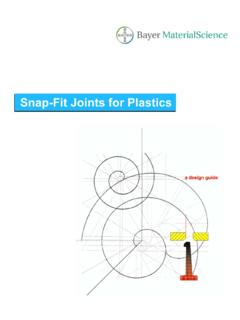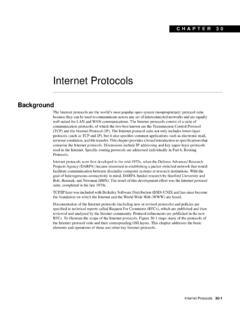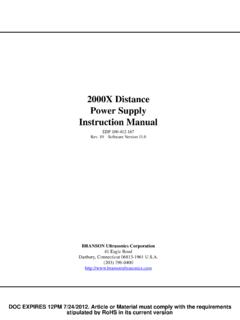Transcription of Snap-Fit Book Final 11-05
1 3 The illustration above shows a photograph oftwo Snap-Fit models taken in polarizedlight; both have the same displacement (y) and deflective force (P).Top:The cantilever arm of unsatisfactorydesign has a constant cross section. The non-uniform distribution of lines (fringes)indicates a very uneven strain in the outerfibers. This design uses 17% more materialand exhibits 46% higher strain than the opti-mal :The thickness of the optimal Snap-Fit arm decreases linearly to 30% of the orig-inal cross-sectional area.
2 The strain in theouter fibers is uniform throughout the lengthof the Common features Types of snap joints Comments on dimensioningBCantilever Snap Joints Hints for design Calculations Permissible undercut Deflection force, mating force Calculation examplesCTorsion SnapJoints Deflection Deflection forceDAnnular SnapJoints Permissible undercut Mating force Calculation exampleEBoth Mating PartsElasticFSymbolsContentsPage 2 of 26 Snap-Fit Joints for plastics - A Design GuideCommon featuresSnap joints are a very simple, economicaland rapid way of join-ing two different com-ponents.
3 All types of snap joints have incommon the principle that a protruding partof one component, , a hook, stud or beadis deflected briefly during the joining opera-tion and catches in a depres-sion (undercut)in the mating the joining operation, the Snap-Fit fea-tures should return to a stress-free joint may be separable or inseparabledepending on the shape of the undercut; theforce required to separate the compo-nentsvaries greatly according to the design. It isparticularly im-portant to bear the followingfactors in mind when designing snap joints: Mechanical load during the assemblyoperation.
4 Force required for Joints General A Page 3 of 26 Snap-Fit Joints for plastics - A Design Guide5 ATypes of snap jointsA wide range of design possi-bilities existsfor snap view of their high level of flexibility, plastics are usually very suitable materialsfor this joining the following, the many design possibili-ties have been reduced to a few basic principles have been derived forthese basic most important are: Cantilever snap joints The load here is mainly flexural. U-shaped snap joints A variation of the cantilever type.
5 Torsion snap joints Shear stresses carry the load. Annular snap joints These are rotationally sym-metrical and involve multiaxial 4 of 26 Snap-Fit Joints for plastics - A Design Guide6 Cantilever snap jointsThe four cantilevers on the control panel mod-ule shown in Fig. 1 hold the module firmly inplace in the grid with their hooks, and yet it canstill be removed when required. An economicaland reliable snap joint can also be achieved byrigid lugs on one side in combination withsnap-fitting hooks on the other (Fig. 2).
6 Thisdesign is particularly effective for joining twosimilar halves of a housing which need to beeasily separated. The positive snap joint illus-trated in Fig. 3 can transmit considerableforces. The cover can still be removed easilyfrom the chassis, however, since the Snap-Fit -ting arms can be re-leased by pressing on thetwo tongues in the direction of the example shown in Fig. 4 has certain simi-larities with an annular snap joint. The pres-ence of slits, however, means that the load ispredominantly flexural; this type of joint istherefore classified as a "cantilever arm" fordimen-sioning 4: Discontinuousannularsnap jointSnap Joints/General A Page 5 of 26 Snap-Fit Joints for plastics - A Design GuideTorsion snap jointsThe tor-sion snap joint of the design shown foran instrument housing in Fig.
7 5 is still uncom-mon in thermoplastics, despite the fact that it, too,amounts to a sophisticated and economical join-ing method. The design of a rocker arm whosedeflection force is given largely by torsion of itsshaft permits easy opening of the cover under aforce P; the torsion bar and snap-fitting rockerarm are integrally molded with the lower part ofthe housing in a single snap jointsA typical application for annular snap joints isin lamp housings (Fig. 6). Here, quite smallundercuts give joints of considerable 5: Torsion snap joint on a housing made of Makrolon polycarbonateFig 6: A continuous annular snap jointoffers a semi-hermetic seal and is betterfor single assembly applicationsAPage 6 of 26 Snap-Fit Joints for plastics - A Design Guide8 Combination of different snapjoint systems The traffic light illus-trated in Fig.
8 7 is an example of an effectivedesign for a functional unit. All the compo-nents of the housing are joined together bysnap : Housing and front access door engage atthe fulcrum1a. The lugs1b(pressurepoint) hold the door open, which is usefulfor changing bulbs. The cantilever hook2locks the door. Thedoor can be opened again by pressing thehook through the slit in the housing at2. The reflector catches at three points on theperiphery. Either a snap-fittin hook 3a or apressure point3bmay be chosen here, sothat there is polygonal deformation of theinner ring of the housing.
9 The lens in the front door is either produced in the second of two moldings4aor, if a glass lens is desired, this can beheld by several cantilever snaps4b. The sun visor engages at5like a bayonetcatch. Good service-ability and low-costproduction can be achieved with carefullythought-out designs such as calculation procedures applicable tovarious types of joints are briefly describedon the following pages, but in such a way asto be as general as possible. The user cantherefore apply this information to types ofjoints not dealt with all the Snap-Fit designs that follow, it isassumed initially that one of the mating partsremains rigid.
10 This assumption represents anadditional precaution against material fail-ure. If the two com-ponents are of approxi-mately equal stiffness, half the deflectioncan be assigned to each part. If one compo-nent is more rigid than the other and the totalstrength available is to be utilized to thefullest, the more complex proceduredescribed in Section E must be is said in the remainder of thebrochure takes into account the fact that theplastics parts concerned are, for brief peri-ods, subjected to very high mechanicalloads.










